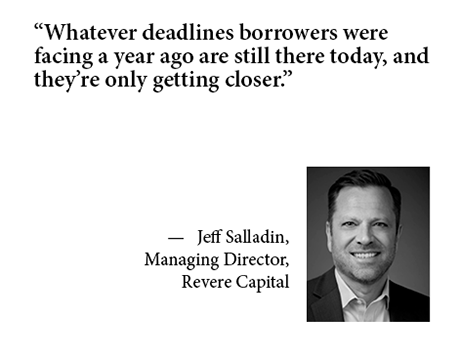Last fall’s ebullience over the Federal Reserve’s likelihood of cutting the federal funds rate early and frequently in 2024 quickly faded as inflation remained too high for the Fed’s liking. Wall Street traders who make wagers on the Fed’s actions keep pushing their rate cut bets further into the year, according to CME Group, a derivatives marketplace. In early March, for example, nearly 75 percent of traders wagered on a rate cut in June. As of early June, less than 2 percent expected one. The most recent Fed meeting, on June 13, has confirmed this assumption that a rate cut is at least months away, if not longer.
If and when the central bank cuts rates this year, the cost of capital is unlikely to approach the historically low levels of the last few years. As a result, the growing interest rate mantra of “higher for longer” may be finally convincing commercial property buyers and sellers to meet on pricing.
New York-based research organization MSCI Real Assets recently noted that commercial property sales continued to slow in the first quarter of 2024 — a year-over-year decline of 16 percent to $78.9 billion. But it suggested that investors might be encouraged by a “narrower gap in price expectations between buyers and sellers” in some property segments.
Jeff Salladin, who leads the real estate debt team for Revere Capital, is beginning to see some firsthand evidence of the improving landscape. Higher-quality deals are coming across the Dallas-based debt fund’s desk compared with this time a year ago. Among other transactions, Revere recently provided financing for a land deal along Austin’s popular South Congress corridor.
Additionally, Revere is providing financing for a combination office and medical office property near a major Dallas hospital, and the borrower intends to increase the medical office tenancy. Revere is also receiving multifamily, retail, industrial and other opportunities.
“I’m not saying that everything is healed, and investors aren’t necessarily feeling as certain as they’d like to feel,” says Salladin, a managing director with Revere. “But the best way to put it is that there’s less uncertainty in the market.”
Navigating the Unknown
Indeed, investors would feel more comfortable if they had a better idea of how the world was going to look six months from now, he points out. Wildcards such as the conflicts in Ukraine and the Middle East, the failure of Republic First Bank in April and the presidential election are just a few risks weighing on investment psyches.
On the positive side of the ledger, if not returning to the 2 percent target as quickly as the Fed would like, inflation appears to at least be leveling off, Salladin says. Meanwhile, after taking stock of their real estate loan portfolios over the last several months and coming to terms with the interest rate environment, banks are lending again — but selectively, he emphasizes.
Partnerships having disagreements, funds coming to the end of their life and estates liquidating assets have been among the primary drivers of investment and lending activity over the past several months. But now time is beginning to play a more frequent role in how buyers and sellers view the market. Notably, many property owners are facing approaching loan maturities or the end of an extension and have to act, Salladin says.
“The clock is ticking away,” he observes. “Whatever deadlines borrowers were facing a year ago are still there today, and they’re only getting closer.”
Cautious Optimism
Although dealmaking is still subdued, signs of an uptick in activity have brightened prospects for 2024. Revere is in the midst of producing monthly loan volumes approaching levels not seen since the Fed started raising rates. That’s far better than last spring, when it received few if any opportunities worth exploring, let alone funding. If volumes remain at their current pace, it could translate into a good year for the firm, Salladin adds.
At the same time, the warehouse credit window has reopened. When making a loan, that factor is allowing Revere to replace some of its risk capital with lower cost financing from other lending sources to enhance its yield. The firm recently secured an additional line of credit that it can use across several deals, for example, and some banks are now more willing to provide such capital on a transaction-by-transaction basis.
“A year ago, we spent months and months looking for back leverage, and it just wasn’t available. It finally started loosening up in December,” he remarks. “The banks aren’t back to where they were — two years ago you could call a bank and get a commitment pretty quickly. But they’re back to the point where we can actually generate the kind of yield we’re looking for and still preserve capital to deploy elsewhere.”
— By Joe Gose. Revere Capital is a content partner of REBusinessOnline. For more information about the content partner program, click here.


